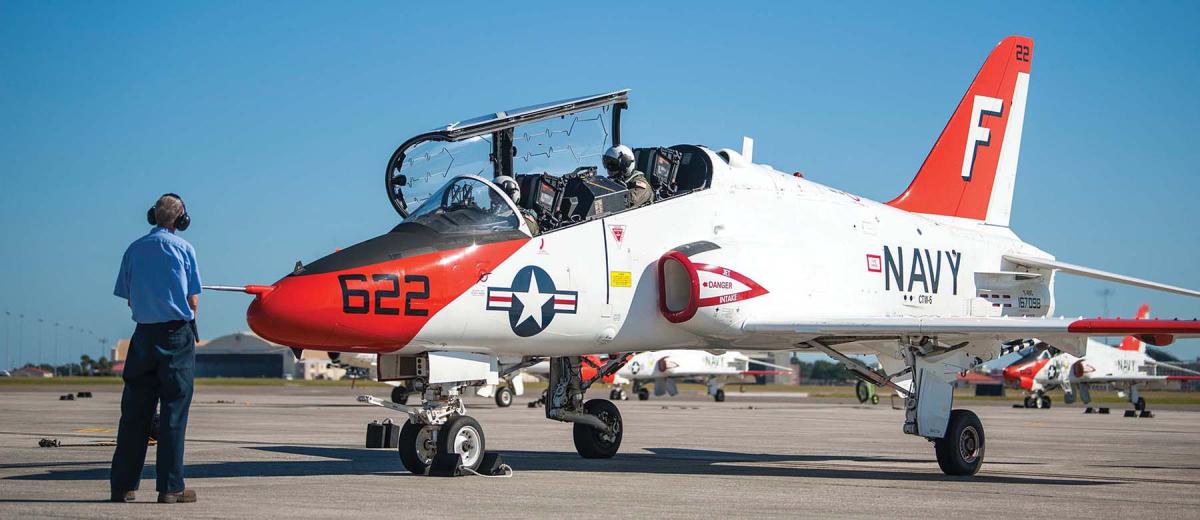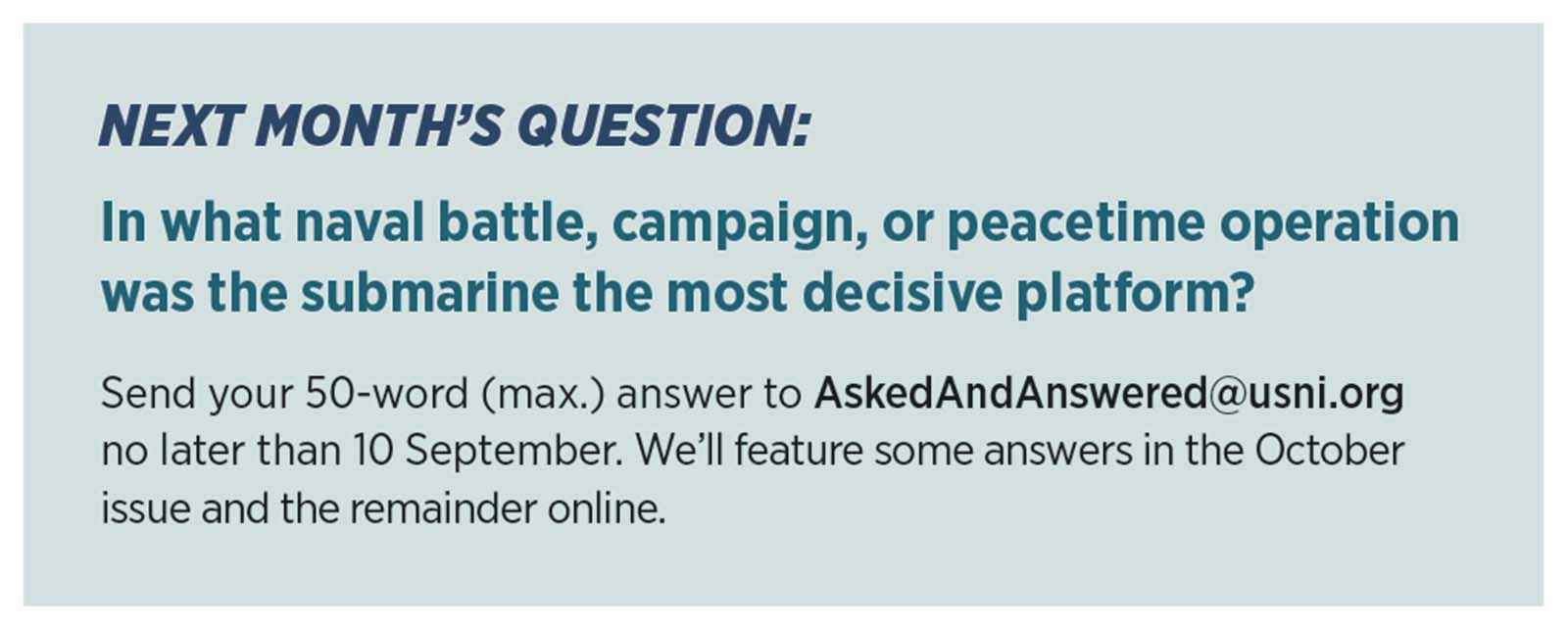Commander W. Alex Buell, U.S. Navy
Getting through the helicopter instrument pre-checkride. The three-hour brief on all rules and regulations was a bear. During the flight, I changed my flight plan, handled emergencies, and flew mostly without stabilization and partial panel. It made my instrument check a breeze and in hindsight was good for me.
Captain Jerry Staats, U.S. Navy (Retired)
The hardest part of my naval aviation flight training was putting up with flight instructors who were “screamers” and realizing it was just them and, maybe, not me.
Captain Art Wagner, U.S. Coast Guard (Retired)
Taming the SNJ-5 in basic after primary in the sweet-flying Beech T-34B Mentor. Once mastered, it was a favorite—but always respected.
Admiral James A. Winnefeld, U.S Navy (Retired)
Some will say that carrier qualifications were the hardest part of naval flight training. Indeed, landing on an aircraft carrier, alone, for the first time, is like nothing else (until, further down the line, after you get your wings of gold, you get to do it at night!). However, the hardest part for me was wondering whether some fluke of timing, or a bad day, or some other factor beyond my control would rob me of my dream of flying the F-14 Tomcat.
Captain Robert C. Rubel, U.S. Navy (Retired)
Trying to land a TA-4 at night from the back seat after my instructor became incapacitated. I had just entered advanced jet training and was on a radio instrument hop under the hood returning to McCain Field at Meridian Naval Air Station, Mississippi. The ground-controlled approach controller reversed her glideslope calls, calling me high when I was low. Fortunately, the hangar doors were open, and I could see where I was before I hit the ground.
Captain Jim Davis, U.S. Navy (Retired)
I was 28, with five years as a black-shoe sailor transitioning to aviation. Two tough areas were academics and physical training. The water part was easy, having grown up in Miami, but as an advertising major in college I struggled at “the little red schoolhouse.” My motto was, “2.5 flies.” If I pass a test and get my Wings of Gold as a naval flight officer, I would get the same flight pay as the 4.0 aviator.
Lieutenant General Robert S. Walsh, U.S. Marine Corps (Retired)
After breaking overhead the USS Lexington (CV-16) for the first time, I looked down and could not believe how small she looked! Only peer pressure got me to an arrested landing. I remember my knees shaking so much I could not taxi. It took the yellow shirt waving madly at me and the Air Boss giving me some “gentle” encouragement for what seemed like minutes before my knees stopped shaking enough to taxi clear.
Robert Fey, U.S. Navy Veteran
I showed up in Pensacola with an engineering degree and a ton of enthusiasm, and once I shaved a few seconds off my obstacle course time, indoctrination was a breeze. Up at Whiting Field, it was another story. The hardest thing was processing relative motion and making corrections in the approach turn and landing flare. Patience from VT-3 instructors and the rugged T-34 are all that got me through to advanced training, wings, and the P-3 Orion fleet.
Admiral William Gortney, U.S. Navy (Retired)
The hardest part of getting my wings was getting my wings. Never studied harder in my life. How much student naval aviators invest in preparation and how hard they work can influence the needs of the Navy in a powerful way. Naval aviation is not an inherently dangerous profession, but it can be terribly unforgiving to those that do not respect or prepare for the hazards that reside within it.
Captain James A. Metcalfe, U.S. Navy (Retired)
My first landing. Not ones on the USS Lexington (CV-16), but my first solo landing. My instructor was a screamer. As we entered landing patterns my troubles would begin with my instructor’s screaming. I flunked solo check flight and was assigned another instructor. On my first flight with him, he was quiet. Finally, he said “do some landings.” Following several safe landings and a full stop, he got out and said “you’re fine—go do some solo landings.” That was it.
E.J. Niemiec, U.S. Navy Veteran
I underwent basic jet training at VT-7, Naval Air Station Meridian, Mississippi, in 1966. The hardest part was basic and radio instrument flying, including partial panel, unusual attitudes, and approach to ground-control authority pickup while partial panel. Flying in formation and carrier qualifications at VT-4 were a snap compared with that.
Admiral Tim Keating, U.S. Navy (Retired)
Naval aviation requires sterling performance every time, regardless of seniority or experience. For example, a naval aviator may have 750 traps, but the 751st demands the same concentration and application of skills as did the first trap in the training command. The “white-knuckle factor” may decrease over time, but the degree of difficulty is a constant.
Lieutenant Colonel Will Steinke, U.S. Marine Corps
Hurricane Ivan. It hit Pensacola toward the end of basic in 2004. We were not cleared to evacuate until the night the storm hit, and I did not even have time to empty my fridge. On returning two weeks later, my neighborhood looked like a warzone. My apartment smelled of death from the rotten food. The tasks we were given included cleaning up hazardous material without personal protective equipment—hard to refuse when your clean-up officer-in-charge is also a flight instructor. Flight operations were delayed more than a month.
Captain M.W. Newman, U.S. Navy (Retired)
After observing for years naval aviators, ashore and afloat, the hardest part of earning their Wings of Gold was having to leave the O-Club at sunrise! But they always did it with style and grace (or whatever her name was). Launch the ready-five!
Lieutenant Commander Steven R. Moffitt, U.S. Navy
One of the most difficult elements on one’s path to wings is getting comfortable with failure. More than that, a student must develop the mental toughness and resilience to overcome failures quickly, often within seconds. Aviators do not have the luxury to walk away after a botched landing attempt or poorly executed maneuver. They must pick themselves up, dust themselves off, and continue operating at their best until the mission is complete.
Captain Joe Littleton, U.S. Navy (Retired)
This question is way too easy. Staff Sargent P.T. McNeil, U.S. Marine Corps, my Aviation Officer Candidate School Drill Instructor in 1971.
Captain George L. VandeWater, U.S. Navy (Retired)
On receiving my Navy wings in June 1955, the hardest thing was learning I was to become a Pensacola flight instructor. Saved by the intervention of my NAS Kingsville flight instructor, Lieutenant Bob Nave, I instead went to a fleet squadron and a happy 33-year career as a naval aviator.
Commander Michael Winkler, U.S. Navy (Retired)
The branding event for a helicopter rescue aircrewman training for deployment to Vietnam in 1969 was SERE (Survival, Escape, Resistance, Evasion) School at Warner Springs, California. Yes, it got physical. Every “SERE Tiger” has a special memory of the Star-Spangled Banner!
Jim McFarlane, U.S. Navy Veteran
Anyone who flew the old pre-electronic era single engine, single seat fighters and/or bombers will tell you the same thing: Qualifying on the ship at night for the first time.







